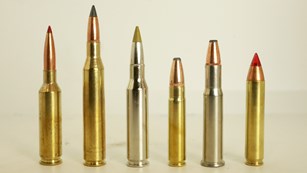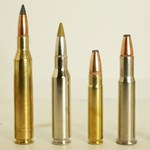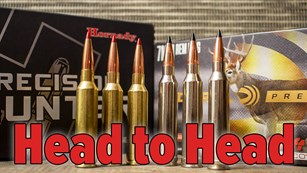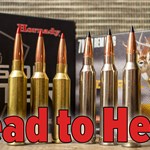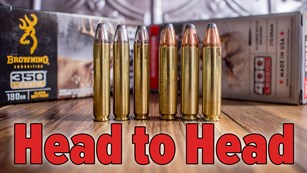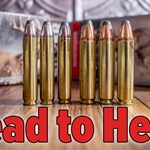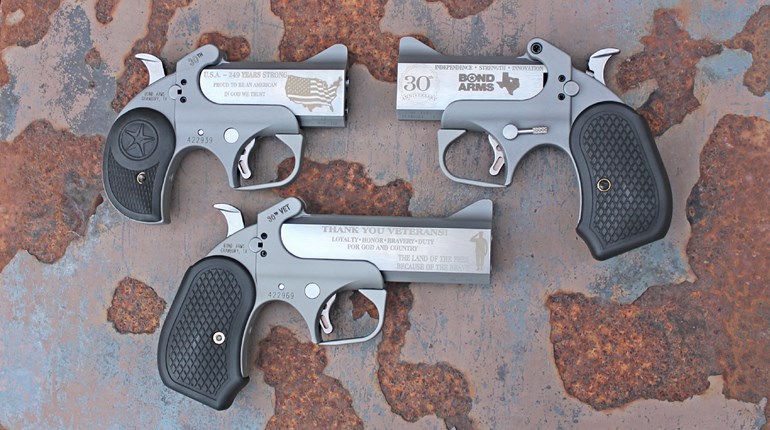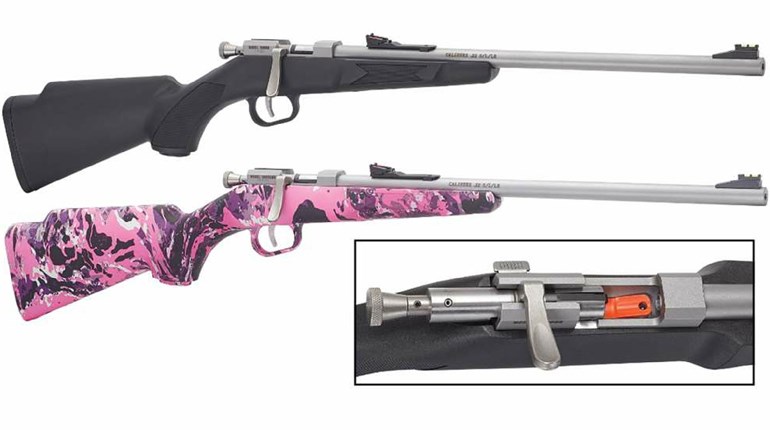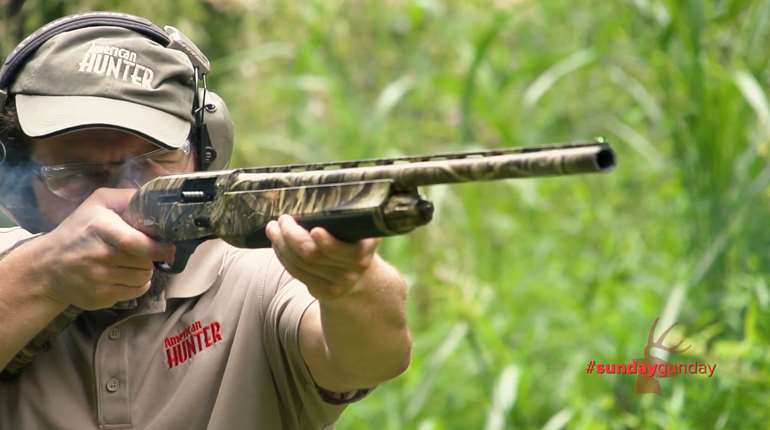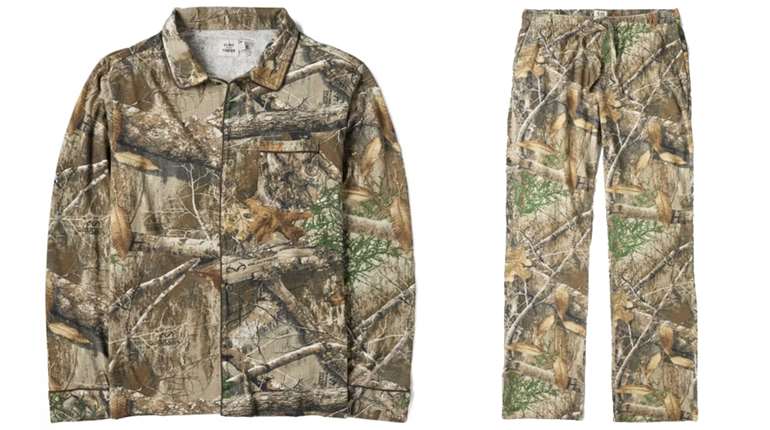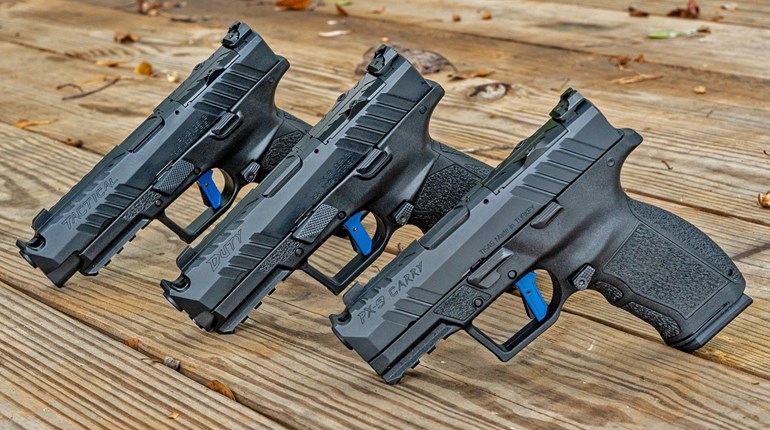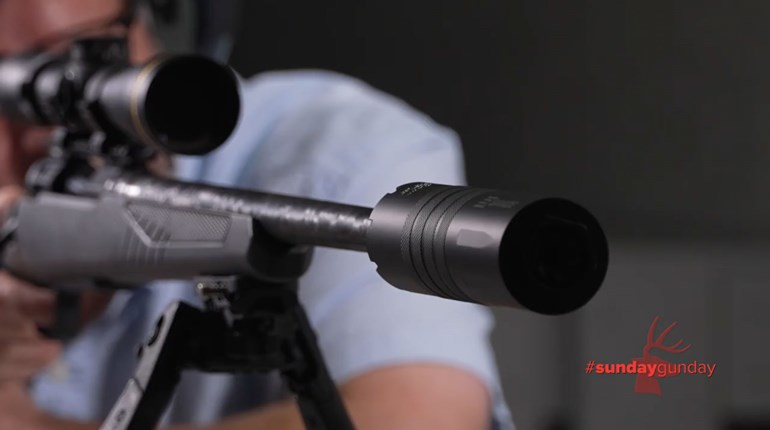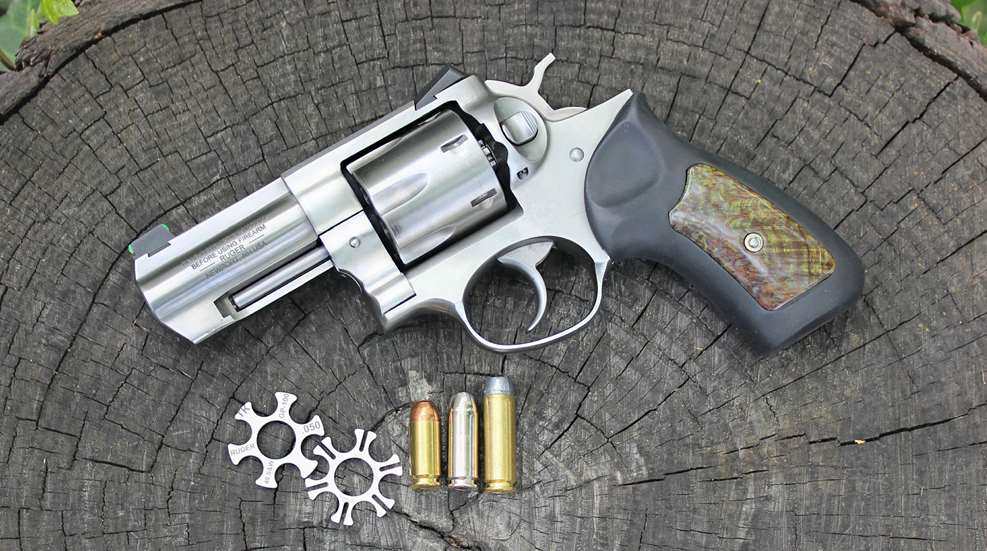
Recently, we posted a review of an in-house custom Magnum Research BFR revolver. This particular single-action wheeler stands out from the crowd because of its tri-caliber configuration. It shipped from the factory with a total of three interchangeable 6-shot cylinders chambered in .40 S&W, 10mm Auto and the lesser known, but more potent, 10mm Magnum pistol cartridge. This was the first vehicle for the 10mm Magnum that I've worked with and the results were impressive. You can read the full review here.
After seeing the 10mm Magnum in action using a well made 6.5-inch barrel single-action, I wanted to keep exploring its performance potential when fired from other platforms. But the truth is, there are just not that many options to choose from at this point in time. The AMT AutoMag IV semi-automatic pistol—the gun this round was originally developed for—has been out of production for over three decades. To the best of my knowledge, no manufacturer has yet to offer a factory-configured pistol-caliber carbine chambered in 10mm Magnum. And it would be a tricky business to convert an existing 10mm Auto carbine because the 10mm Magnum cartridge's increased case length would require a redesign of the action and magazines.

I've found two current production handguns that could potentially be chambered in, or converted to fire, 10mm Magnum. I've talked to their respective manufacturers about both of them. A terrific fit would be the Magnum Research Desert Eagle L5. On paper, it looks like the .357 Mag. version might only need a barrel and bolt swap to be compatible with this round. However, it would take time-consuming and expensive R&D work to find out for certain. So, please don't start calling them to find out when this gun is going to launch. If they ever do decide to move forward with the project, trust me, I'll let you know.
Another distinct possibility could be a Bond Arms break-action pistol. Currently available chambered in .45-70 Gov't., .50 AE or .44 Mag., the single-shot Cyclops would handle the pressures generated by the 10mm Magnum cartridge with ease. And, until proven otherwise, it may be possible to convert a Bond Arms 10mm Auto double-barrel pistol. But once again, that pesky R&D is getting in the way. Gordon Bond politely told me that they are currently busy building guns people actually want to buy. It's safe to say that even though a Bond Arms 10mm Magnum is not completely off of the table, it’s currently tucked into the same file folder as the request for a .41 Rem. Mag. caliber conversion barrel that I submitted about 15 years ago.

That leaves the most commonly followed route to shooting this relatively obscure cartridge, which is to ream the chambers of a double-action 10mm Auto revolver’s cylinder from a depth of 0.992-inches to 1.290-inches so as to accommodate the longer 10mm Magnum. As it turns out, that's the only modification required to convert one of these revolvers into a three-caliber gun. As a fan of multi-caliber revolvers, I wanted to give it a try.
Choosing a Base Gun
When it comes to selecting a 10mm Auto revolver for conversion to 10mm Magnum, the pickings are slim but excellent. The most common base guns have been members of the Smith & Wesson Model 610 series. Bouncing into and out of the company's catalog since their introduction in 1990, the 610s were re-introduced in 2019 and have been in steady production ever since. Built using an N-size frame, the same frame used for the Model 629 chambered in .44 Mag., these guns are more than strong enough to manage 10mm Magnum pressure levels. The standard 6-shot, satin-finished stainless models include 4-inch and 6-inch barrel versions. But if you dig around online you may find one of the distributor exclusives with 3-inch barrels, matte finishes, and so on. I've wanted to test the 610 for quite some time and just received a 4-inch version to test drive (stay tuned for that review).

The other current production revolvers that I'm aware of are a pair of 6-shot stainless steel Ruger GP100 revolvers. The 4-inches barrel Match Champion is a smooth operator configured with competition in mind. The other is the 3-inch barrel Wiley Clapp Lipsey's Exclusive. After evaluating this gun a few years back, I chose to add it to the collection. Its features, reliability and performance make it an ideal fit for the trail-to-town revolver role.
With the right 10mm Auto ammunition, this short-barrel GP100 handles nicely, carries comfortably and hits harder than a .357 Mag. with reasonable levels of felt recoil. This revolver is not intended to fire .40 S&W per se. But with the right set of moon clips it can safely chamber and fire this shorter and softer-shooting pistol cartridge. This is a handy second caliber option for less expensive practice sessions or should there be a time when .40 S&W is the only ammunition on hand. Modifying this short-barrel GP100 cylinder to chamber 10mm Magnum would provide for a third and potentially more potent caliber option fired from the same. The trail gun package, plus more power if needed, was a good fit for my needs so I went with this GP100 as the base gun.

Reeder Custom Guns and Chigs Grips
I checked in with the good folks over at DoubleTap ammunition to inquire about a gunsmith for this project. Since they are the primary manufacturer and distributor of 10mm Magnum ammunition these days, it seemed likely they would know who to talk with. Without any hesitation, they pointed me directly to Reeder Custom Guns. Gary Reeder is a custom gunsmith who has been transforming sporting handguns and rifles into literal works of art for more than three decades. Thankfully, the company also takes on less involved modifications like this one. Gary was kind enough to meet with me over the phone to walk me through what turned out to be an utterly easy process.

First, I needed to remove the GP100's cylinder assembly from the revolver's frame. Only the cylinder needed to be sent into the shop for the chambers to be reamed to the right depth. Next, it needed to be wrapped and packed for shipping. All that was left to do then was to drop it off with the shipper, which was made simpler and less expensive since it was just a component and not a complete firearm or a serial numbered receiver. The re-chambering work was listed on the website for $300 and I was told it should take about two weeks to complete. The modified cylinder was shipped directly back to me in fine condition. All I had to do was reinstall it into the frame and the gun was ready to use.
Since this is technically a custom gun project, I was hoping to do a bit more to dress up this GP100 to mark its transformation into a 3-caliber revolver. But this is a working trail gun with a set of sights I like, an action I'm happy with and a factory install compact rubber grip that fits my hands like it was made just for me. All that was really left to modify were the grip’s checkered wood inserts. But having swapped out those inserts with this custom Ruger SP101, I knew the right set would make all the difference.

I found just what I was looking for on the Chig's Grips website. The company is owned and operated by Chad Robinett who specializes in unique hardwood grips for 1911 pistols and Ruger revolvers. They are handmade by Chad using natural materials with options ranging from the traditional to the truly eye catching. No two sets are alike. When looking through the available options, I found this striking set of multi-color stabilized black ash burl panels ($40). They are sized for Ruger SP101 or GP100 compact grips. But if you are ordering them for a GP100, let Chad know so that he can add the requisite ports to fit that model. I'm very pleased with the look, fit and feel of these unique inserts. Quite frankly, the photos do not do them justice. In fact, I’m ready to start collecting his grips as well as the guns they fit.
TK Customs Full Moon Clips and Tools
When this GP100 was a dedicated 10mm Auto, the full moon clips provided with the gun served one primary purpose: to engage the ejector star to press all six spent cartridge cases out of the cylinder in preparation to reload. The clips are also pretty handy for inserting fresh rounds as well. But mechanically speaking, it was not strictly necessary to use moon clips to fire this ammunition. The rimless 10mm Auto cartridges were headspaced off of the cartridge mouth. This allowed un-clipped cartridges to be safely inserted into the chambers since they would stop at the right depth for the firing pin to strike the primers. But without a clip, the spent cases have to be poked out of the cylinder one at a time using a pin punch, cleaning rod or similar tool.

Now that the cylinder has been reamed for 10mm Magnum, that is the only round which will headspace correctly without a moon clip. As you can see in the included photo, 10mm Auto and .40 S&W rounds drop down deeply into the chambers where they are well out of reach of the firing pin. For those cartridges, the moon clips now serve triple duty: loading, unloading and head spacing. With a gun like this, the moon clips become just as important as a reliable magazine for a semi-automatic pistol.

With this in mind, I reached out to TK Customs. This company is well known in revolver circles for offering top quality clips and the tools for managing them. They currently offer a Ruger GP100 10mm Auto package on their website which includes ten stainless steel 0.032-inch thick full moon clips along with their loading device and an unloading tool. I would like to take a moment and thank TK for taking the time to mark their clips very clearly with the make, model, caliber and clip thickness. The vast majority of clips on the market have no markings at all. Their clips are strong and flexible too, making them much less likely to get kinked or bent. They proved to be a real pleasure to work with throughout the course of testing.

The TK Customs representative I was working with checked in with me to verify if I would be shooting .40 S&W as well as 10mm Auto and 10mm Magnum. When I said yes, they added a 5-pack of their .40 S&W specific GP100 clips to the order. These clips are 0.050-inches thick which, they have found, ensures positive operation with the subtle differences of the .40 S&W cartridge cases. They worked flawlessly, just like the ten 10mm Auto clips that came with the GP100 kit.

Moon clips can be loaded and unloaded without any special tools. But I don't recommend it. It's slow, hard on the finger tips and there is a chance of bending the clips in the process. TK's milled aluminum loading tool uses a lever to snap fresh cartridges into place painlessly. The unloading tool looks like the hollow handle of a multi-bit screwdriver. The hollow end is placed over a spent cartridge case to remove it from the clip. But here's the trick. The top of the tube has a ledge that can engage the edge of the moon clip. Rather than yanking the case out, you give the tool a gentle twist so that the ledge engages the edge of the clip. This pops the case out so that it then drops down into the hollow of the tool's tube. This allows the used cases to be poured into a container or onto the bench top instead of having to pick them up off the ground. Trust me, these two tools pay for themselves very quickly.

Three-Caliber Performance Potential
With firearms, an increase in ammunition flexibility may contribute to a reduction in down-range accuracy. This is clearly evident with the .45 Colt/.410 Bore revolvers. The 3-inch cylinder versions can chamber 3-inch and 2.5-inch .410 shells, filled with birdshot, buckshot or mixed payloads, along with .45 Colt revolver cartridges topped with cowboy lead bullets, defensive hollow points or snake shot. Yes, these guns are impressively flexible as to ammunition compatibility. However, they don't pattern nearly as well as dedicated .410 shotguns or .45 Colt-only revolvers. In regards to the .45 Colt, the reduction in accuracy is due in no small part to the bullet rattling through roughly 1.7-inches of un-rifled cylinder chamber before reaching the barrel.

The modified GP100 tested here has a cylinder that measures 1.56-inches from front to back according to a set of digital calipers. Based on the measurements taken using the gear on hand, it looks like a bullet fired from 10mm Magnum cartridge in this gun is going to pass through about 0.40-inches of chamber before making the jump through the cylinder gap into the barrel's forcing cone. And don’t forget, that portion of the chamber is sized to fit the bullet diameter.

The 10mm Auto round I checked will travel through close to 0.65-inches of chamber. About 0.25-inches of that chamber is sized for the cartridge case, not the bullet. Last but not least, the .40 S&W bullet will have to move through 0.80-inches of chamber, half of which is cartridge case-size. This gives the .40 S&W more time to pick up a wobble before engaging the barrel. To some, this may sound like splitting hairs. But from what I've seen in my own testing, as well as other reports, these little dimensional differences can have a noticeable impact on accuracy. That’s why I was curious to see what the 3-caliber performance would be for this particular modified cylinder.
At the Range
This was the first time that I've shot .40 S&W through this revolver. The recoil was moderate, almost mild, with the Federal American Eagle and Hornady Critical Duty loads used for the formal performance testing. They made for easy shooting on par with firing standard pressure .38 Special through a .357 Magnum revolver. The 10mm Auto, as usual, spoke with authority when fired through the 3-inch barrel. Although the recoil is peppy, I don't find it to be punishing. Fiocchi USA Hyperformance and Winchester USA Ready 10mm Auto loads were used for the formal testing.

The revolver's dynamics changed noticeably when switching over to the DoubleTap Ammunition 10mm Magnum loads. The two loads tested included this company's 135-grain controlled expansion hollow point and a 200-grain flat-nosed hardcast load. Both of these rounds put on quite the light show with a notable shift up in recoil. I would not call it intense, and certainly not painful, but it was at the top end of the stout recoil scale. Here is the complete set of range results:

Lessons Learned
I'd like to wrap up this conversation by saying that I've come away from this project quite pleased with each of its primary components. This is still one of my favorite revolvers—the grip panels make me smile and the TK Customs moon clip system is among the best I've worked with. I plan to check in with both of them for future endeavors. As for the ammunition evaluated, it is top-grade grade stuff from companies that I've been working with for many years. But in the end, did the constituent parts come together to form the ammunition performance whole I was looking for? Let's break it down by the numbers.
The guideline I follow for acceptable defensive accuracy with an iron-sighted handgun at a given distance is to look for 5-shot bench-rested group sizes between 3- and 3.5-inches. When firing 3-shot groups, as shown here, the group averages are typically a bit smaller than that. Since this test was conducted at 15-yards, then 3-shot groups of around 3-inches would be topping out the useful accuracy for this particular gun and the ammunition fired.
The .40 S&W performance numbers are not as tight as the 10mm Auto but they were satisfactory for the 15-yard test distance. The bullet energy dropped a bit, but that was expected. However, they held on to enough energy that if someone should choose to load this gun with defensive .40 S&W hollow points for reduced recoil personal protection from contact distance out to around 15 to 20 yards, it would do the trick. For the 10mm Auto loads, there was no appreciable impact to the accuracy or bullet energy that could be attributed to the 10mm Magnum caliber conversion. In fact, the Winchester USA load kept its groups under 2 inches while maintaining the largest percentage of bullet energy, making it the best performer of the test set.

As for the 10mm Magnum loads, the results indicate that they have been optimized for use in handgun hunting revolvers with 6-inch or longer barrels. This was evidenced by the bright muzzle flashes and the significant drop in bullet velocity. The 135-grain load traveled 818-fps slower than the listed velocity with a 67-percent drop in bullet energy. A 200-grain round loaded to the same specs (topped with a different bullet) performed quite well when fired from the 6.5-inch barrel BFR. But in this case, it lost 399-fps of velocity with nearly a 57-percent reduction in bullet energy. As a result, the Winchester 170-grain 10mm Auto load was the hardest hitter of the evaluation.
Are short-barrel revolvers and 10mm Magnum ammunition a good mix? This 3-inch GP100 works nicely with 10mm Auto and well enough with .40 S&W. But based on these results with the ammunition tested, it appears that a shorter barrel like this one does not provide enough burn time for the powders to fully develop. We see similar big flash/slow bullet results when firing centerfire rifle cartridges through pistol-length barrels. Neither the ammunition nor the gun are ‘bad,’ they are just not the best fit for each other. And so, going forward, I will most likely pursue 10mm Magnum platform tests with actions and barrel lengths better suited to this cartridge. But then again, if Bond Arms does get around to building one for me to test drive, I’m in like Flynn!





